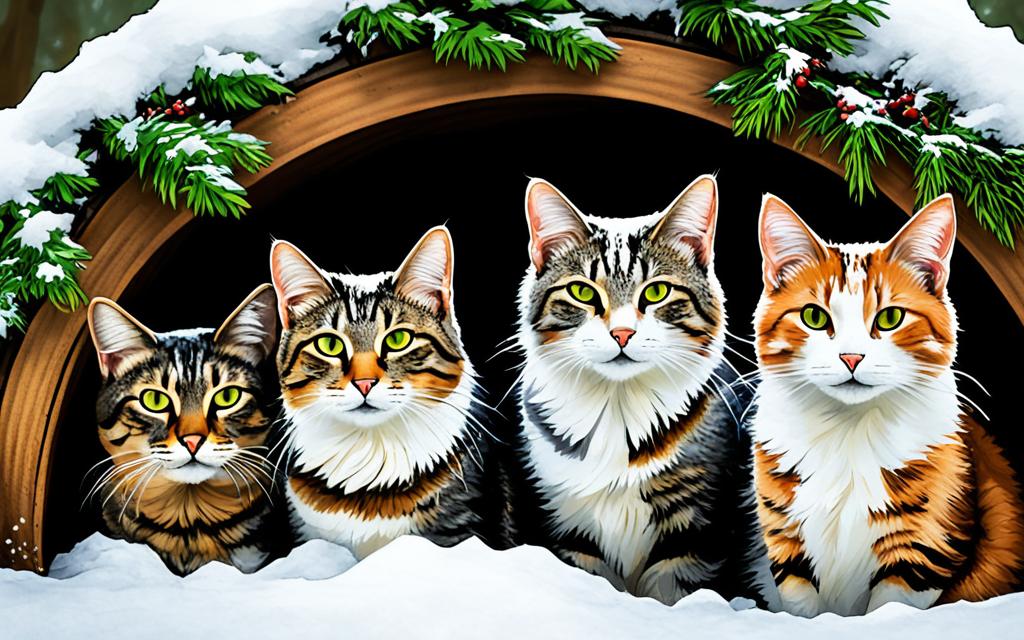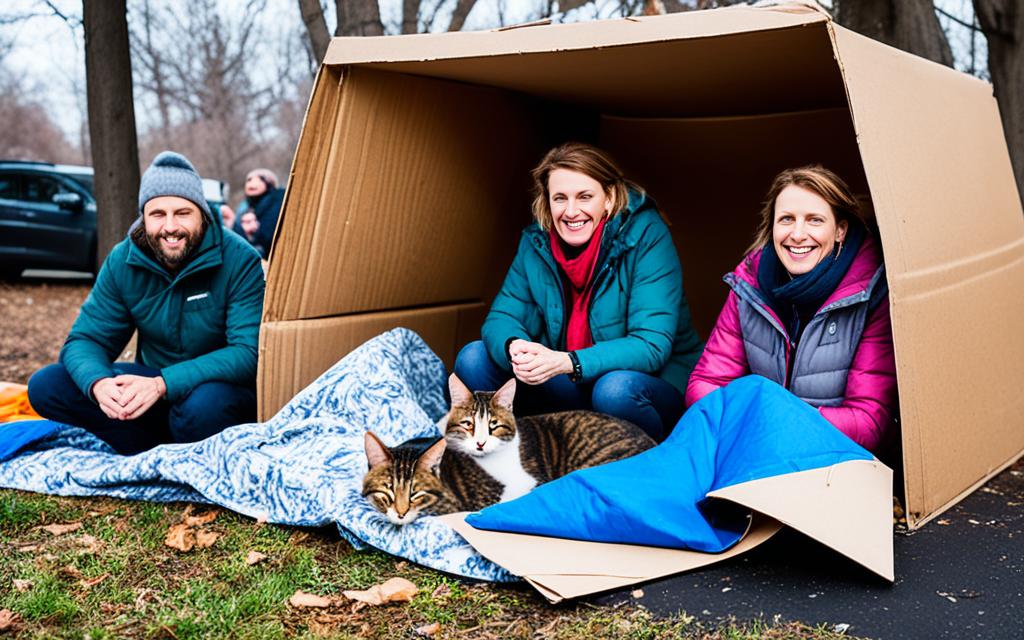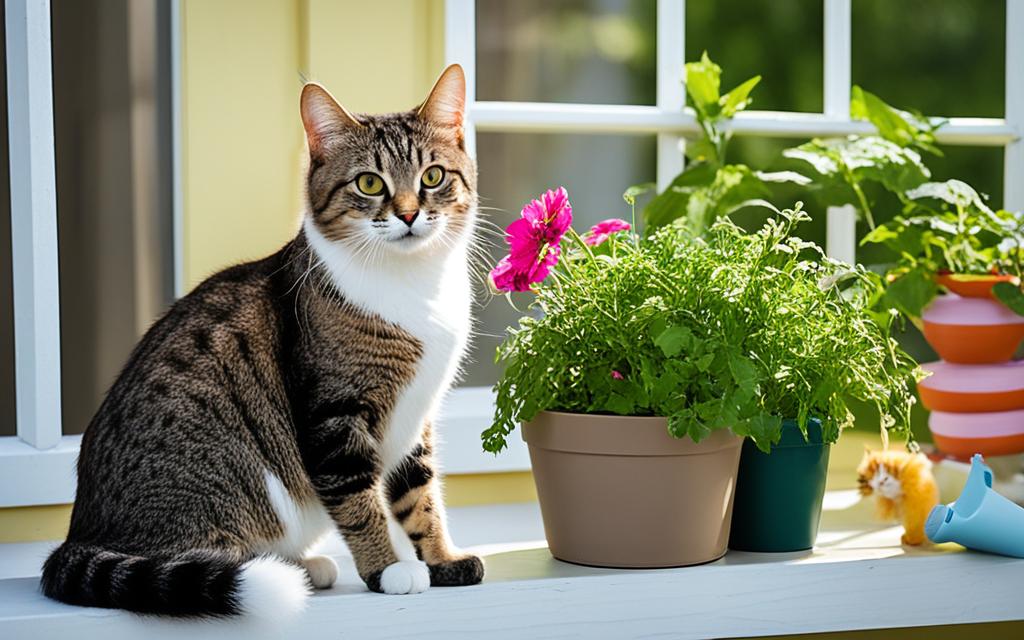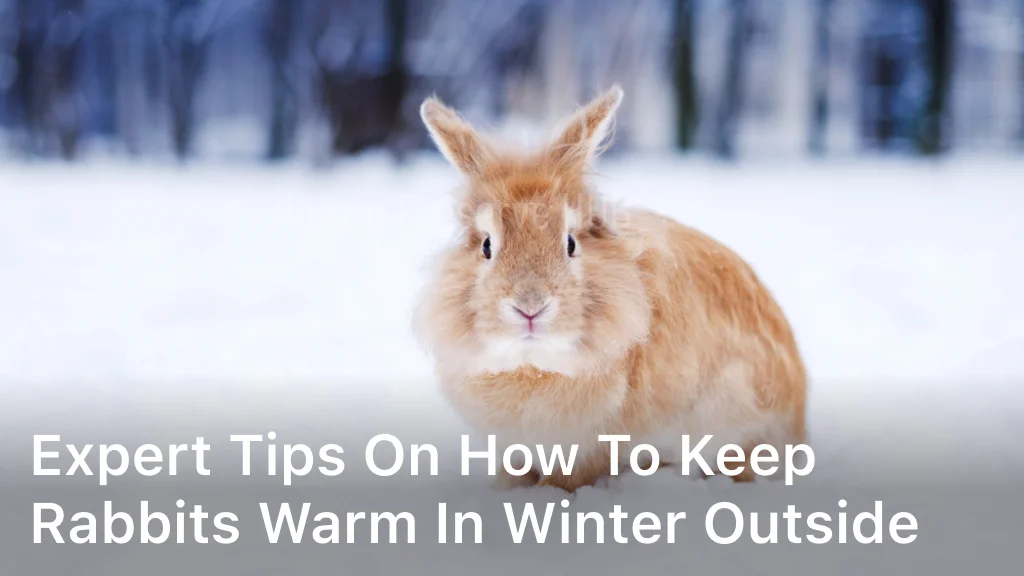How to Keep Feral Cats Warm in the Winter – Tips

How to Keep Feral Cats Warm in the Winter – Winter is here, and it’s tougher for our feline friends, especially feral cats. Feral cats are those who avoid people and live outside. They spend all their time looking for food, water, and warm places. They are skilled at surviving but a little help from us can make their winter safer and healthier.
This article will give you tips on helping feral cats and outdoor pet cats in the winter.
Understanding Feral Cats and Their Winter Challenges
When winter arrives, feral cats face tough times finding food, water, and warm shelters. These cats haven’t learned to trust humans and are often very afraid. Yet, they’ve developed smart ways to survive outside all year. This includes hunting and finding shelter.
What Are Feral Cats?
Feral cats are not used to people and are scared of them. They might cover a large area, much more than pet cats. This roaming helps them find what they need like food, water, and safe places to hide.
The Survival Instincts of Feral Cats
Feral cats have amazing skills for living in tough places, even in winter. They are good at hunting and hiding from people. But, the cold months are hard because they need a lot of energy to find food, water, and stay warm.
The Importance of Providing Winter Care
During winter, feral cats might need our help to stay safe and healthy. While outdoor pet cats enjoy some care from their owners, they may not be ready for severe cold. It’s important to support both feral and outdoor cats in winter.
Providing Food and Water for Outdoor Cats in Cold Weather
In winter, outdoor cats need more food to stay warm. Giving them extra food helps save their energy. Use canned or wet food since it’s easy to digest.
It’s also important to give them fresh food and water daily. Make sure the leftovers don’t freeze.
Increasing Food Portions
Serve wet food in plastic containers and feed them dry food that won’t freeze. To keep food and water warm, heat them before putting them out. Or, you can use heated electric bowls.
Choose deep bowls over wide ones and put them where the sun shines. This stops the water from turning into ice. Adding insulation foam under the dishes can also help.
Preventing Food and Water from Freezing
For winter, offer wet food in plastic containers and stick to mostly dry food. Make sure to warm up canned food and water. Alternatively, using heated electric bowls is a good idea.
Opt for deep bowls rather than wide ones to prevent the water from freezing. Placing them in sunny spots also helps. Adding insulation foam under the bowls can keep them from freezing too.
Building Feeding Stations
The best way to feed community cats during winter is by creating feeding stations. This keeps their food, water, and the cats themselves safe from the cold.
Preparing Outdoor Cat Shelters for Winter
Cats can find their own shelter, but you can also help by creating warm, safe places for them. A good shelter size is two by three feet, and at least 18 inches high. It should fit three to five cats, depending on their size. The doorway should be small to keep out bigger animals. Adding a door flap helps block cold air and keeps cats safe from predators.
Insulating with Straw and Mylar Blankets
Use straw to keep the shelter dry. Hay, blankets, and towels get wet easily and don’t keep cats warm. Mylar blankets can also be used. They reflect the cat’s body heat back to them.
Elevating and Positioning the Shelter
Keep the shelter off the ground to avoid cold and damp. Position it so the door isn’t facing strong winds. Putting it against a wall helps protect from the weather.
how to keep feral cats warm in the winter
It’s key to look after outdoor cat shelters to keep feral cats warm and safe in winter. Always check the shelters to ensure they’re in good condition and clear of snow. This stops cats from getting trapped inside.
Checking and Maintaining Shelters Regularly
If cats aren’t using the shelters, try making them more inviting. You can add catnip, silver vine, or small treats to attract cats. Since cats may like different types of shelters, offering various choices is a smart move.
If shelters still go unused, find where the cats sleep and improve that area. Use straw or similar materials to make it warmer.
Making Shelters Appealing to Cats
It’s vital to give cats different shelter options for warmth and dryness. Keeping the shelters clean and cozy, and adding new options, makes a big difference. This ensures feral cats are safe and warm during winter.
Providing Multiple Shelter Options
Having several quality shelters lets feral cats pick the best spot for them. Regular checks and enhancements can improve cats’ winter survival greatly.
Winter Precautions for Outdoor Cat Safety
Winter brings cold weather, making it even more important to keep our outdoor cats safe. Cats sometimes choose cars to warm up underneath or inside. This is especially true for kittens.
Checking Your Car Before Driving
Start by looking under your car and checking the engine. Tap lightly on the hood to see if any cats are hiding inside. Listening for meows can help too.
Always check your car before you start it in winter. Cats might be there looking for warmth. Make sure they are not before driving off.
Avoiding Harmful Chemicals and Antifreeze
Be careful with products to melt snow and ice. Salt and chemical deicers can be dangerous if cats swallow them while grooming. Use safe deicers that aren’t harmful. These are sold in pet stores.
Antifreeze is also very toxic to cats. Keep it locked away where they can’t get to it. This helps prevent serious accidents.
Preventing these dangers is crucial for our outdoor cats. Simple steps can make a big difference in their safety. Let’s do our part to keep our furry friends warm and well through the winter.
Trap-Neuter-Return (TNR) in Winter
Getting spayed or neutered makes cats healthier. This means they can handle the cold better when they’re returned outdoors. However, if it’s too cold for you, it’s also too cold for TNR activities.
Trapping Cats During Warmer Hours
When it’s cold, trap cats in the warm part of the day. Change their feeding times so they’re more active when you need to trap them. Always check traps often and don’t leave cats in them for long.
Adjusting Feeding Schedules
Change the feeding times of the cats for TNR in winter. Make sure they’re most active during the warmer hours. This makes trapping easier and safer for the cats.
Providing Proper Post-Surgery Care
After surgery, keep the cats in a warm place. This is vital all year but especially in cold weather. Watch the temperature during their transport to prevent health issues.
Caring for Outdoor Pet Cats in Winter
Make sure indoor/outdoor cats have shelter, so they’re safe on cold nights. A warm bed in your garage or barn is a good option. It should be dry and protect them from chilly winds.
Providing Fresh Water
Keep water fresh since it freezes in winter. Many cats get dehydrated because of this. Giving them wet food helps too, as it has a lot of water.
Increasing Food for Energy and Insulation
Feed your cats more dry food, leaving nearly none in the bowl by the next meal. This keeps them warm as they burn extra calories in winter.
Offering Warm, Dry Shelter Options
Ensure your cats’ access to shelter on cold nights. A cozy place in your garage or barn is a great choice. It shields them from the cold and keeps them dry.
Protecting Paws and Skin in Cold Weather
During winter, outdoor cats deal with special problems, mainly keeping their paws and skin safe. Helping your outdoor or feral cat stay comfy and secure is simple. There are a few easy steps you can follow.
Using Petroleum Jelly on Paw Pads
Apply a bit of petroleum jelly or chapstick on your cat’s paw pads. This helps protect them from ice and harsh chemicals. These chemicals on the ground can hurt your cat’s paws. After they come in, gently clean and dry their paws. Then, apply a bit more jelly.
Avoiding Harsh Chemicals and Salt
Avoid letting your cat come in contact with anti-freeze since it’s deadly, even in small amounts from licking paws. In winter, cats may get dry, itchy skin. So, steer clear of snow-melting chemicals and salt. These can be dangerous if your cat licks them off its fur or paws.
Moisturizing Dry Skin
Wet cat food can help moisturize your cat from the inside. Adding liquid fish oil to their food can also help. Regularly brushing your cat’s coat spreads oils, which prevents dry, itchy skin.
Building Your Own Outdoor Cat Shelters
Making shelters for cats outdoors can be a great group effort. Invite friends, family, and local clubs or groups to help. Look for materials like scrap wood from stores or contractors. Friends might have old dog houses you can use. You can also repurpose a large storage bin for this project. By working together, you can make a warm place for outdoor cats without spending much.
Finding Inexpensive or Free Materials
To keep your costs low, reach out to building-supply stores and contractors for spare wood. Check with those in your circle for any available dog houses. Even a simple storage bin can become a shelter. This way, you might save a lot on the materials needed.
Appropriate Insulation Options
Using straw lets cats nest and keep warm. Pillowcases filled with packing peanuts or shredded paper can also work. In very cold areas, consider using Mylar as insulation. It will help keep the shelter warm by reflecting the cats’ body heat.
Helping Outdoor Cats Survive the Winter
Cats have incredible survival skills. They’ve evolved over thousands of years to live and thrive in different places. But sometimes, outdoor cats need some help, especially when the weather gets really harsh.
The Resourcefulness of Outdoor Cats
How outdoor cats tackle winter shows their amazing resilience. They’ve learned how to find warm spots, hunt for food, and save energy. Their skills in finding places that keep them warm and sharing these spots are outstanding. They know how to manage with what’s available.
The Importance of Community Support
In winter, outdoor and feral cats depend on us for support. It’s important that communities come together to help them. When people join forces to provide food, water, and shelter, it can keep outdoor cats safe and well during the coldest season.

Conclusion
We can all help feral and outdoor cats in winter. By ensuring they have food, water, and shelter, we make a big impact. This also means being careful for their safety. Supporting local initiatives is another great way to help.
It takes only a bit of effort and kindness to change their lives. When we come together, we offer them a chance to do well in winter. They’re amazing at finding ways to survive, especially when we support them.
By giving them food, a safe place, and our watchful eye, we do a lot. Our actions help these cats get through cold seasons. This improves not just their lives, but the unity and natural balance in our area too.





